Join More Than 50,000+ Subscribers and get latest camera news and rumors
NEW CAMERA VIDEOS ON YOUTUBE
|
By admin, on March 14th, 2025
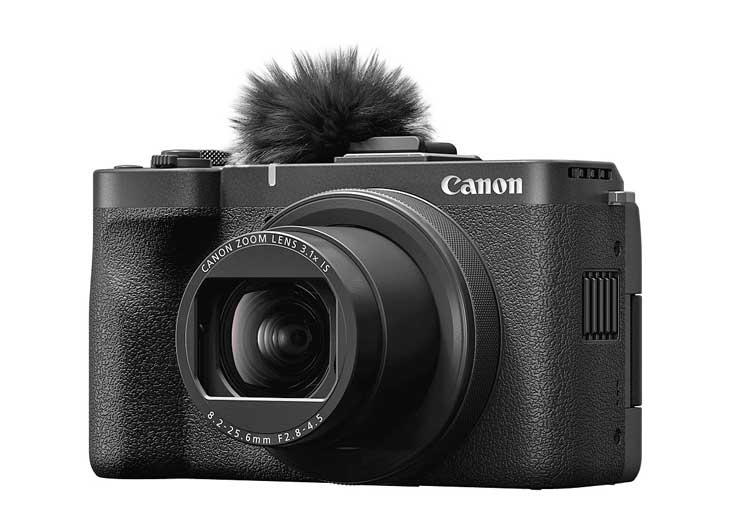
According to the latest rumor surfaced over the web, Canon will be announcing their Canon RV, Canon PowerShot V1, as well as Canon R50 V on or around March 26, 2025. Let’s explore the possible set of details we have related to these cameras.
1. Canon V1 Camera
The Canon V1 camera is a compact camera that is already announced in the Asian region. We already have the full core specifications and even a comparison with the Sony ZV-E10 camera. So, V1 is about to arrive officially in the USA and European region. Canon has already announced it in Asia, check details below

The image of the Canon RV camera was leaked a while ago, which gives a clear indication that the announcement is near. We have also analyzed the image of the leaked Canon RV camera. From the design, it looks like an entry-level interchangeable-lens mirrorless vlogging camera made for beginners. With its price and features, it will compete against the existing Sony ZV-E10 camera. Just like we have the Canon R100 camera in the entry-level zone for photographers, the Canon RV will be the beginner model for the vlogging mirrorless series.
3. Canon R50 V
Canon R50 V is also rumored to be announced on the same day, but we have the least information about this camera, and we are waiting for more details related to the same. So, we are very sure about two announcements—the first, which has already been announced in the Asian region, the Canon V1 compact camera, and the other, the Canon RV. As soon as I get more information, I will be updating you.
Stay tuned stay updated
Get LIVE RUMORS –> FACEBOOK | TWITTER | INSTAGRAM to get live news + Canon rumors 24X7
source Canonrumor.com
By admin, on March 11th, 2025

Canon just dropped a bombshell—they have clearly said no to a pixel-packed version of the Canon R1 camera, neither R1X or any one, Canon said BIG No to High Res Fullframe Flasghip Camera. In an interview at CP+ in Yokohama, Japan, with the PetaPixel team, a Canon representative clearly said a big NO to a higher-resolution variant of the Canon R1 camera.
So, what do you think? Is it a misstep or a masterstroke? Let’s discuss further.
Canon EOS R1: A Flagship Built for Speed, Not Pixels
Canon R1 is a camera made for speed and not pixels. It’s a custom-tailored camera specifically made for sports shooters and wildlife photographers—those who need lightning-fast performance from their camera.
As we all know, the Canon R1 camera features a 24.2MP sensor with a continuous shooting speed of 40 FPS in RAW, as well as Canon’s latest generation of AI autofocus. In fact, it’s a dream camera for many photographers out there.
But here’s the kicker—some photographers, or maybe even YOU, would love to have, or at least the option of, a higher-resolution Canon R1—something that uses a 45-megapixel stacked sensor and directly competes against the Nikon Z9 or Sony’s 50-megapixel monster, the Alpha 1 Mark II.
But it’s Canon’s decision, and the team led by Go Tokura, Executive Vice President and Head of the Imaging Group, has closed the doors on all possibilities of a high-resolution flagship camera.
“We consider the flagship to be at the pinnacle of our lineup, which means we’re not going to have two flagship models,” Tokura told PetaPixel. “We’ve put everything—the best performance and trust—into the EOS R1.”
Translation?
Canon is very clear about its flagship strategy. Right now, they believe speed doesn’t require high resolution. And if you want to shoot landscapes, architecture, or anything that demands a super high-resolution sensor, they have a clear message:
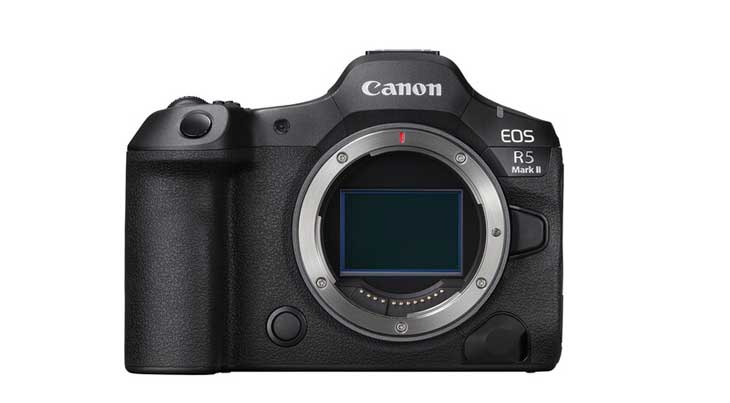
You can go for the R5 series. If you need more than that, you’re free to look elsewhere.
But I need your feedback—do you think Canon is right in their decision, or are they actually missing the mark? Drop your thoughts in the comments below.
Why No High-Res R1 or Canon R1X? The Science Behind the Decision
Let’s break it down and understand why Canon is thinking this way. First, we need to understand that Canon isn’t just being stubborn—it’s physics.
If you go for a higher-resolution sensor, it means smaller photodiodes, resulting in lower sensitivity, more noise at higher ISOs, and compromises in dynamic range. For a camera like the Canon R1, which is built to excel in both image quality and performance, Canon has to maintain a balance.
We also have to remember a key part of the interview, where Tokura said: “If we focus on just one aspect of performance—like resolution—it would destroy the balance. Our 5-series handles high resolution instead.”
So, we have to understand that the Canon R5 Mark II, with its 45MP sensor, is Canon’s answer for pixel lovers out there.
But here’s the catch—the Canon R5 Mark II lacks the R1’s rugged build, integrated grip, and flagship-level ergonomics that professionals love to have in a high-resolution camera. So Canon is very clear: you should either pick speed or resolution.
If you pick speed, you get the Canon R1. If you want a high-resolution sensor, you get the R5 II.
What do you think? Does this decision sit right with you, or does it feel outdated in 2025? Should Canon have at least considered a flagship-level solution with a high-resolution sensor, just like other camera makers have?
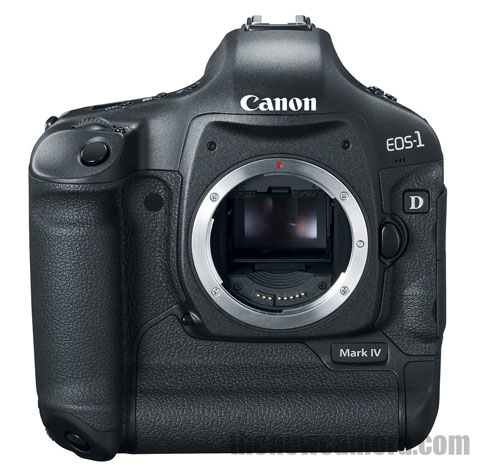
Back in the DSLR Days, They Had Two Flagships—Why Not Now?
Back in the DSLR days, Canon did split its flagship lineup into two flavors: the speed-focused 1D and the resolution-heavy 1Ds.
Canon has been making their 1-series cameras for decades—it’s nothing new. In the DSLR era, their research and development team was smart enough to offer two flagship models based on market demand and technological limitations at the time. They had the speed-focused 1D and the resolution-focused 1Ds.
So, if they already did it in the past—why not now?
Tokura’s take is clear: “We would probably never consider developing another model using the same body as the EOS R1.”
But let’s be real—times have changed. Technology now allows for a high-resolution flagship camera, just like the Nikon Z9 and the Sony Alpha 1 Mark II. And as I mentioned, Canon already had two different flagship models in the DSLR era—so why not now?
Yes, we do have alternatives like the R5 II, but that’s not a real solution for professionals who need a unified body like the R1.
The Bottom Line: Love It or Leave It
For professional photojournalists, wildlife photographers, and sports shooters who need a low-resolution, high-speed camera, the Canon R1 is a match made in heaven.
But for those who were craving a high-resolution flagship, sorry folks—Canon is not in the mood to create a high-res R1 / R1X or its equivalent anytime soon.
Yes, we do have the R5 II, at least in that series, but for now, a high-resolution flagship remains off the table
Get LIVE RUMORS –> FACEBOOK | TWITTER | INSTAGRAM to get live news + Canon rumors 24X7
source petapixel.com
Update Log: The article was updated on 9:05 am, Tuesday, 22 April 2025 GMT ny thenewcamera.com team
By admin, on March 7th, 2025
We have the first leaked image of the Canon RV camera. The Canon RV camera is Canon’s dedicated camera made for content creators. Just like we have the Sony ZV series, similarly, in Canon, we have the V series. In the V series, we already have a few compacts, and recently, Canon announced the V1 compact camera.

Now it’s time for a mirrorless V series camera. These are going to compete directly against the Sony ZV10, ZV10 Mark II, or maybe the ZV E1—who knows soon?
Canon RV Mounting Options
From the leaked images, it is very clearly visible that the camera is mounted from the side of a grip. So we have two options to mount the camera: vertically and horizontally, depending on the type of content creation you require.
Top Features & Controls
On the top of the camera, we have a certain button that resembles the shutter button of the Sony ZV series camera. Along with that, we also have a power zoom lever. The lens attached to the Canon RV camera supports power zoom functionality, and we can see the designation of T and W, meaning it can be operated manually as well as via the lever. This allows for a very smooth cinematic zoom experience with the lens.
Control Dials for Customization
Just after the zoom lever and the video recording button, we have two Mode dials:
- One is dedicated to different modes.
- One is a custom dial that can be set to a preferred ISO, meaning it’s a custom zone for professional users.
Hot Shoe for Accessories
In the center of the Canon RV camera, at the very top, we have a multifunctional Canon hot shoe that can be used for Canon wireless microphones and other accessories made for the RV series camera.
Built-in Microphone & Audio Ports
On the extreme left side, we can see multiple vents for the microphone, which indicates a high-quality 3-capsule-style microphone setup inside the Canon RV body.
Connectivity & Ports
On the very extreme left side of the camera, we can clearly see multiple rubber compartments that Canon has sorted out beautifully. The ports include:
- Microphone and headphone port
- Micro HDMI port
- USB-C port (for data transfer and recharging the camera on the go)
Front Design & Branding
On the front of the camera, we can clearly see:
- A microphone button
- A lens release button
- Canon RV branding
- A tally lamp, just like in professional cinema cameras
Expected Sensor & Specifications
So that’s the analysis of the leaked image we have right now. Most probably, the camera will use the same 24-megapixel APS-C CMOS sensor that we have seen inside the Canon R50 and Canon R10 cameras.
Expected Announcement Date
Although we are waiting for the final specifications of the camera, since the image has been leaked, it is expected that the announcement of the camera is very near.
We will update you as soon as we get any details related to the Canon RV camera.
Canon RV Camera (Leaked Specifications)
| Feature |
Details |
| Camera Series |
Canon V Series (Mirrorless) |
| Target Audience |
Content Creators |
| Sensor |
24MP APS-C CMOS Sensor (Expected, similar to Canon R50 & R10) |
| Mounting Options |
Vertical & Horizontal Mounting |
| Lens Compatibility |
Supports Power Zoom Functionality |
| Zoom Control |
T & W Designation (Manual & Lever Operation) |
| Control Dials |
Two MODE Dials (One for Shooting style, one for custom settings like ISO) |
| Hot Shoe |
Multifunctional Canon Hot Shoe (Supports Canon wireless microphones & accessories) |
| Microphone |
High Quality / Similar to Sony 3 capsule design |
| Ports |
– Microphone & Headphone Port
– Micro HDMI Port
– USB-C Port (Data Transfer & Charging) |
| Shutter Button |
Similar to Sony ZV Series |
| Tally Lamp |
Yes (Similar to professional cinema cameras) |
| Video Recording |
Dedicated Video Recording Button |
| Branding |
Canon RV Branding on Front |
| Expected Announcement |
Soon (Based on leaked images) |
Get LIVE RUMORS –> FACEBOOK | TWITTER | INSTAGRAM to get live news + Canon rumors 24X7
image source MirrorlessRumors.com
By admin, on March 4th, 2025
The key points of this article suggest Realme and Xiaomi are working on or considering the possibility of an interchangeable lens-based concept smartphone, and one of these latest smartphones was showcased at the MWC conference in 2025.
- Now, the Realme concept phone users, and the best part is you can use the Leica M mount lenses over that smartphone, but the drawback is the mount doesn’t have any electrical contact tools, so you have to use manual focus lenses.
- Xiaomi has two concept smartphones. The first one was showcased back in 2022, the 12S Ultra, which had a 1-inch sensor. Now, the second smartphone has been showcased in 2025, which uses a modular optical system with a 100-megapixel Micro Four Thirds format sensor in the Xiaomi 15 Pro model.
- Smartphone makers are now getting more and more serious about photography, content creation, and videography. In the past decade, we have seen or witnessed smartphone makers already competing with compact cameras.
Impact on Traditional Camera Makers
The key thing is that we have to understand, and it’s even more important for camera makers like Sony, Canon, and Nikon. Smartphones are getting smarter day by day, and now they are moving into interchangeable lens design. Once this happens commercially, the camera makers will take a very big hit in the mirrorless camera market share, which was safe until now.

Realme’s Concept Smartphone at MWC 2025
Now, first, let’s talk about the Realme concept smartphone.
The Realme concept phone was showcased at MWC 2025, which was held in Barcelona. This particular concept features the latest 1-inch sensor, and you can use Leica M mount lenses, like a 73mm portrait lens, to capture cinematic portrait images. You can also attach a 34mm telephoto lens to get 10x optical zoom with the highest possible quality. But the downside is that since it’s Realme’s first smartphone with an interchangeable lens design and they are not into concept phones like Xiaomi, the problem here is their first prototype does not have any electrical contacts between the lens and the smartphone camera system.
Although the Realme concept smartphone design is great and can be loved by professional photographers, those who are heavily into using manual focus lenses, even if it gets produced for consumers, it will have a very limited market space.
However, we must understand one thing: smartphone makers are constantly exploring new concepts and designs to expand their share in the camera market. They are specifically targeting the elite consumer base—those willing to invest a significant amount in high-end camera gear. This very consumer segment also forms the backbone of the mirrorless camera industry.
Xiaomi’s More Advanced Concept Camera
Now, let’s talk about an even more interesting camera concept by Xiaomi, which has been showcased at MWC 2025. But even before that, let me tell you, Xiaomi is not new to making concept camera-based smartphones. Their first concept smartphone was the 12S Ultra, which used a 1-inch sensor with a Leica M mount. Now, you can relate this to the similarities with the Realme concept smartphone, which has been showcased at MWC 2025, exhibiting similar properties that Xiaomi had already shown back in 2022.

Xiaomi’s Groundbreaking Smart Lens Model
But wait, there is more from Xiaomi, and this really surprised us this time.
At MWC 2025, a new concept lens model with its own integrated sensor and physical contact has been showcased.
Now, this particular custom design combines the Xiaomi 15 smartphone with detachable lens modules. This lens module uses a 35mm f/1.4 lens and a 100-megapixel custom-made Micro Four Thirds format sensor, which produces very natural bokeh while shooting video or capturing images. The tonal quality of skin tones and other subjects being captured is directly coming from Leica Lab, as it is co-engineered with Leica Camera Division, Germany.
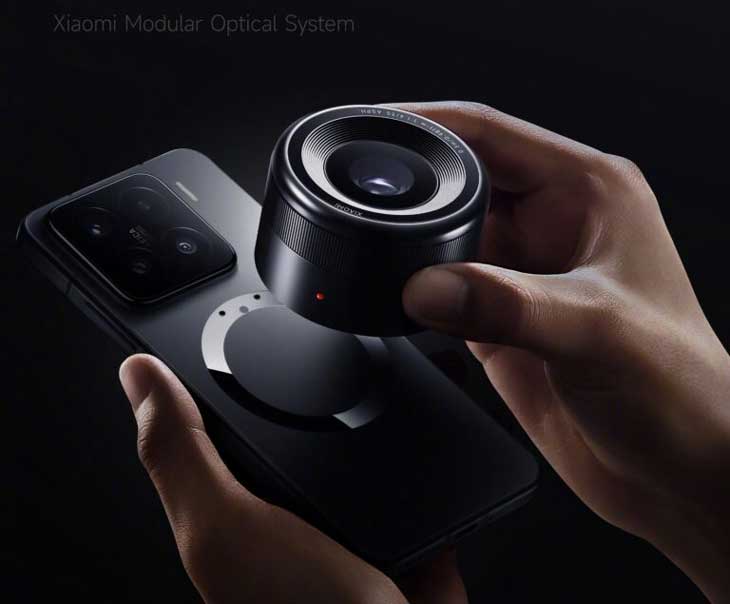
Xiaomi’s New Laser Link Technology
Xiaomi has also shown us the Laser Link technology for quick data transfer up to 10 Gbps between the lens and the camera module. This enables lag-free data transfer between the lens and the camera body. Now, this prototype just shows how serious smartphone makers are about more professional photography and video capture equipment, enhancing the overall experience of cinematography and photography in smartphones.
Comparing Concept Smartphones by Xiaomi and Realme
Below, we have shown three different tables comparing the basic differences between the three concept smartphones showcased by Xiaomi and Realme from 2022 to 2025.
| Feature |
Realme Interchangeable Lens Concept |
Xiaomi 12S Ultra Concept (2022) |
Xiaomi Modular Optical System (2025) |
| Base Sensor |
1-inch Sony CMOS, fixed in the phone |
1-inch 50MP Sony IMX989, fixed in phone |
The phone has its cameras, module has a 100MP Type 4/3 sensor |
| Lens Attachment |
Leica M mount, attached to phone sensor |
Leica M mount, attached to phone sensor |
Magnetically attaches, a separate module with lens and sensor |
| Additional Cameras |
Main and ultrawide, fixed |
In-built 48MP ultra-wide, fixed |
The phone’s built-in cameras are disabled when the module attached |
| Demonstrated Lenses |
73mm portrait, 234mm telephoto |
Compatible with Leica M-series lenses |
35mm f/1.4 lens in module |
| Data Transfer |
N/A (uses phone’s processing) |
N/A (uses phone’s processing) |
LaserLink up to 10 Gbps, pogo pins for power |
| Status |
Prototype, MWC 2025 |
Prototype, not mass-produced, 2022 |
Prototype, MWC 2025, no release schedule |
Impact of These Concept Cameras on the Market
The emergence of Realme and Xiaomi’s concept camera smartphones over the past few years has raised a major question: What will happen if one of these prototypes they are working on enters mass production? Recently, we have seen Realme may not be an immediate candidate for mass production, but a smartphone with a camera or lens module featuring its own Micro Four Thirds format sensor of 100 megapixels is highly production-ready.

Xiaomi’s 100MP Smart Lens Could Kill Mirrorless Cameras
And the worst part is that we have seen the image and video quality of Xiaomi’s latest smart lens modules with a 100MP M4/3 format sensor, and the results are exceptional—far better than any existing smartphone we have seen till now. The background blur and the bokeh are so clear and natural that they rival those generated from large sensors and 35mm f/1.4 lenses. This could literally kill mirrorless cameras out there.
The Future of Photography and Videography in Smartphones
Now, the best part for photographers and content creators is that photography and videography are evolving at a very fast pace. Surprisingly, none of the camera makers are involved in this. Smartphone makers like Realme and Xiaomi are working on concept cameras, and I really like the output of the recent Xiaomi 15 smartphone with a 100MP Micro Four Thirds format sensor. It is highly acceptable for professional photographers, and I would love to see more smart lenses featuring the same sensor in upcoming releases if they plan to do so in the near future.
source Mrwhosetheboss
List of Camera and Lenses Announced in CP+ Show 2025
Follow us on our social pages FACEBOOK | TWITTER | INSTAGRAM to get live Camera News +
By admin, on February 28th, 2025
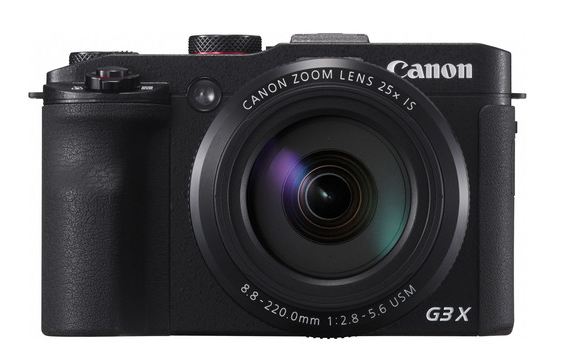
According to the latest rumors coming from the rumor mill, Canon is rumored to announce the Canon V3 camera, very similar to the Canon G3 X high-quality super zoom compact camera. It will carry forward the same sensor that we have seen in the Canon V1 camera—the 1.4-inch 22.4 MP sensor and an optical zoom lens.
The upcoming Canon V3 camera is also said to feature a built-in electronic viewfinder and a more photography-oriented design. This time, the camera will be more photography-core specs instead of videography. That means this time we will not see vents opening on the sides of the camera; rather, it will have a robust build with a deep hand grip and an EVF.
The expected arrival time of the camera is sometime in Q4 of 2025. Let’s hope for the best! We will update you as soon as we get any additional information related to the Canon V3 camera.
Get LIVE RUMORS –> FACEBOOK | TWITTER | INSTAGRAM to get live news + Canon rumors 24X7
CR.com
By admin, on February 21st, 2025
So now, we have the sample images of the recently announced Canon V1 camera. Let’s have a look at these full-size, high-resolution sample images, and you can download them to explore further on your computer or smartphone.
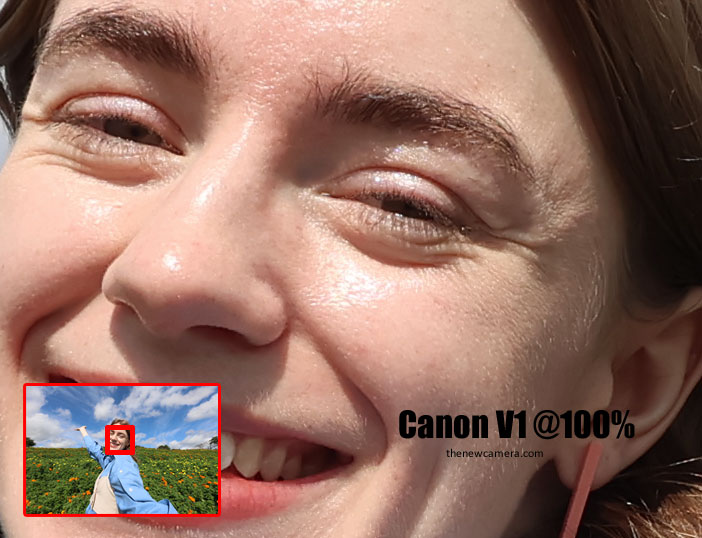

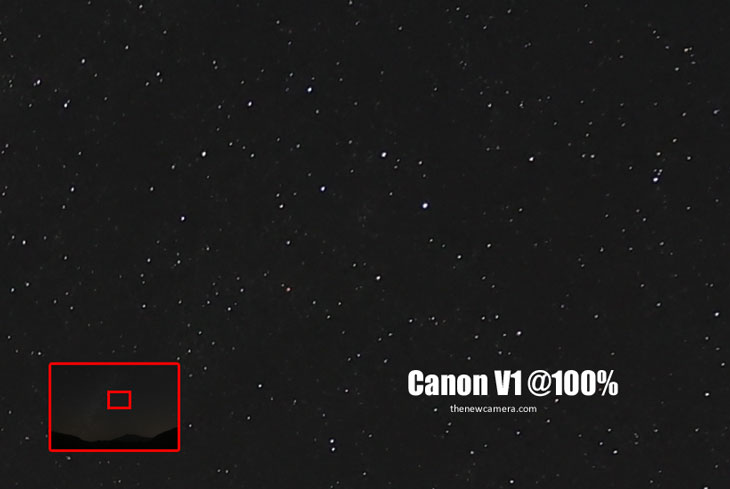

See and download full-resolution samples from here
Get LIVE RUMORS –> FACEBOOK | TWITTER | INSTAGRAM to get live news + Canon rumors 24X7
By admin, on February 20th, 2025

Canon announced the V1 compact camera. The camera features enhanced video core specifications and a built-in fan that has never existed in any compact camera, so it’s very exciting to see how compacts are evolving.
So now, we have a 22-megapixel Dual Pixel CMOS autofocus sensor of 1.4 inches, which is somewhat similar in size to a Micro Four Thirds format sensor. The lens is 16-50mm f/2.8-4.5 with a built-in three-stop ND filter.
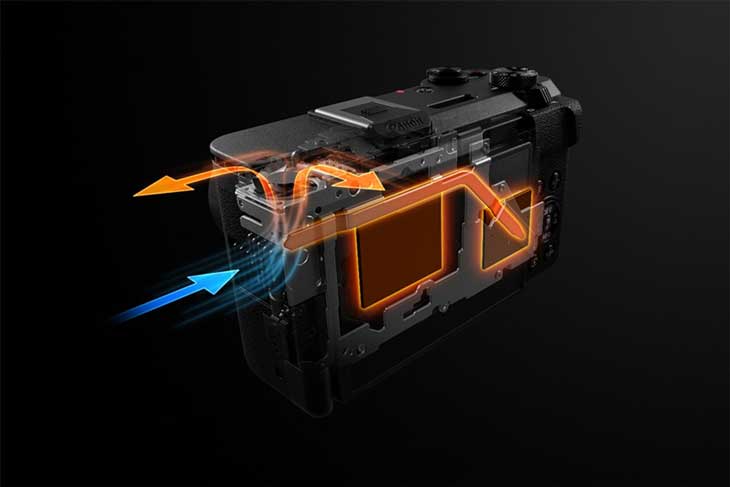
The camera captures 4K 30 FPS video from 5.7K, meaning when you capture 4K 30 FPS, you get the highest resolution possible. However, when you switch to 4K 60 FPS, the camera applies a 1.4x crop in the video image and switches to a 1:1 pixel capture ratio, so that’s not the highest quality output when using the 4K 60 FPS mode.
For still photography, the camera is perfect—you can capture up to 30 frames per second in electronic shutter mode. You also get a fully articulated vari-angle display screen, making it great for photographers as well as content creators.
As mentioned in the body, we have a cooling fan vent, a very good hand grip, headphone and microphone sockets, as well as a multifunctional hot shoe for flash and audio connectors.
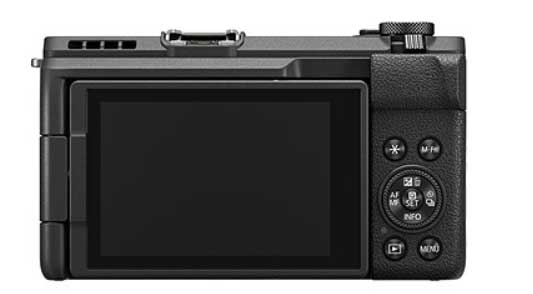
Canon V1 Major Specification
- Sensor: 1.4-inch CMOS, 3:2 for video.
- Pixels: 22.3 million for stills.
- Processor: DIGIC X, fast and sharp.
- Video: 4K 60fps with Canon Log 3.
- Autofocus: Dual Pixel CMOS AF II, snappy.
- Lens: 16-50mm (photo), 17-52mm (video).
- Aperture: Likely f/1.8-4.0.
- ISO: Up to 32,000 for stills.
- Shutter: 1/2000-30s (mech), 1/16000-30s (elec).
- Burst: 15fps mech, 30fps elec.
- Cooling: Fan for 2+ hours of 4K.
- Screen: 3-inch vari-angle, 1M dots.
- Hot Shoe: Multi-function, no flash.
- ND Filter: Built-in, 3-stop.
- Audio: 3.5mm mic and headphone jacks.
- HDMI: Yes, for external output.
- Storage: Single SD (UHS-I).
- Video Features: “Moods” and demo mode.
- Connectivity: USB-C charge/data.
- Price: ~$990 USD (148,500 yen Japan).
Release of the flagship model of the “PowerShot V Series,” the “PowerShot V1” – Full-fledged video and still image functions meet the wide range of needs of creators
Canon V1 Press Release
The PowerShot V1 is the second compact digital camera in the PowerShot V series, which allows users to enjoy full-scale video shooting, following the Vlog camera PowerShot V10 (released in June 2023). Compared to the 1.0-type sensor installed in a normal compact digital camera, the 1.4-type CMOS sensor is about twice the area, achieving high image quality and high sensitivity. In 35mm equivalent, it covers a zoom range equivalent to a focal length of about 16mm to 50mm *1 , and is compatible with a wide range of scenes such as selfies with multiple people, snapshots, and Vlogs. In addition, it combines the functions required by creators, such as high-performance AF and a variety of shooting modes, with a compact body, making it easy to shoot full-scale videos and still images. Canon will continue to expand its models that can both shoot full-scale videos and still images to meet the needs of a variety of users.
Main features
An integrated lens camera that combines professional photography performance with a compact body
The combination of a 1.4-inch CMOS sensor with a maximum effective pixel count of approximately 22.3 million pixels *2 , the first Canon compact digital camera to be equipped with the DIGIC X image engine, achieves a maximum standard ISO sensitivity of 32,000 (when shooting still images). Canon’s proprietary AF system, Dual Pixel CMOS AF II for PowerShot *3 , also achieves high-speed, high-precision AF. Furthermore, the inclusion of the Eye Detection *4 function makes it possible to detect the eyes of animals, whose movements are difficult to predict, in addition to people, making it easy to focus when shooting. With full-fledged shooting performance packed into a compact body, you can carry it around with you on trips and enjoy shooting.
Video recording functions that allow for greater freedom in video expression, including the incorporation of a cooling fan
The camera is equipped with a cooling fan inside, which efficiently releases heat, reducing the impact of temperature rise on video recording time. In addition to realizing 4K crop/60P video recording, it supports “Canon Log 3”, allowing recording with rich 10-bit gradation and excellent color reproduction. Furthermore, shooting modes such as “Review Video”, which is suitable for product reviews, and “Image Stabilization Video”, which is effective for handheld shooting, *5 make video recording comfortable.
High-speed continuous shooting at up to 30 frames per second ensures you never miss a subject, and still image shooting functions enable a wide range of creative expression
When using the electronic shutter, continuous shooting at up to 30 frames per second is possible, making it possible to capture fast-moving subjects. In addition, the camera automatically recognizes the scene and supports difficult scenes such as night scenes and backlit scenes with the “Advanced A+” mode, and “Creative Filters” allow for impressive shots such as diorama and toy camera style shots, and many other functions that enable rich photographic expression.
Get LIVE RUMORS –> FACEBOOK | TWITTER | INSTAGRAM to get live news + Canon rumors 24X7
|
KEEP THIS BLOG ALIVE - Support New Camera Buy Canon Lenses, Buy Music CD or Digital Camera at amazon it helps this site, and you do not pay anything extra, it is just a way to help support this site.

|





















